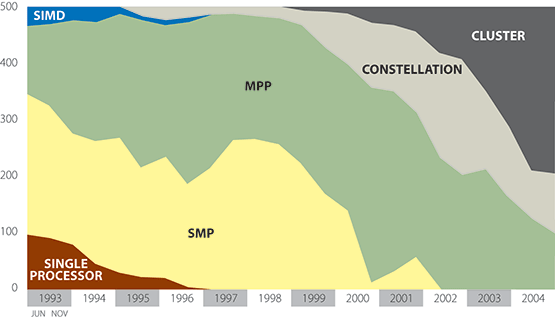At the end of the 1990s, clusters were common in academia but mostly as research objects and not primarily as general purpose computing platforms for applications. Most of these clusters were of comparable small scale and, as a result, the November 1999 edition of the TOP500 listed only seven cluster systems. This changed dramatically as industrial and commercial customers started deploying clusters as soon as applications with less stringent communication requirements permitted them to take advantage of the better price/performance ratio -roughly an order of magnitude- of commodity based clusters. At the same time, all major vendors in the HPC market started selling this type of cluster to their customer base. In November 2004 clusters were the dominant architectures in the TOP500 with 294 systems at all levels of performance (see Fig 2). Companies such as IBM and Hewlett-Packard sell the majority of these clusters and a large number of them are installed at commercial and industrial customers.

In addition, there still is generally a large difference in the usage of clusters and their more integrated counterparts; clusters are mostly used for capacity computing while the integrated machines primarily are used for capability computing. The largest supercomputers are used for capability or turnaround computing where the maximum processing power is applied to a single problem. The goal is to solve a larger problem or to solve a single problem in a shorter period of time. Capability computing enables the solution of problems that cannot otherwise be solved in a reasonable period of time (e.g., by moving from a 2D to a 3D simulation, using finer grids, or using more realistic models). Capability computing also enables the solution of problems with real-time constraints (e.g., predicting weather). The main figure of merit is time to solution. Smaller or cheaper systems are used for capacity computing, where smaller problems are solved. Capacity computing can be used to enable parametric studies or to explore design alternatives; it is often needed to prepare for more expensive runs on capability systems. Capacity systems will often run several jobs simultaneously. The main figure of merit is sustained performance per unit cost. Traditionally, vendors of large supercomputer systems have learned to provide for this first mode of operation as the precious resources of their systems were required to be used as effectively as possible. By contrast, Beowulf clusters are mostly operated through the Linux operating system (a small minority using Microsoft Windows) where these operating systems either lack the tools or these tools are relatively immature to use a cluster effectively for capability computing. However, as clusters become on average both larger and more stable, there is a trend to use them also as computational capability servers.
There are a number of choices of communication networks available in clusters. Of course 100 Mb/s Ethernet or Gigabit Ethernet is always possible, which is attractive for economic reasons, but has the drawback of a high latency (~ 100 μs). Alternatively, there are, for instance, networks that operate from user space, like Myrinet, Infiniband, and SCI. The network speeds as shown by these networks are more or less on par with some integrated parallel systems. So, possibly apart from the speed of the processors and of the software that is provided by the vendors of traditional integrated supercomputers, the distinction between clusters and this class of machines becomes rather small and will, without a doubt, decrease further in the coming years.






